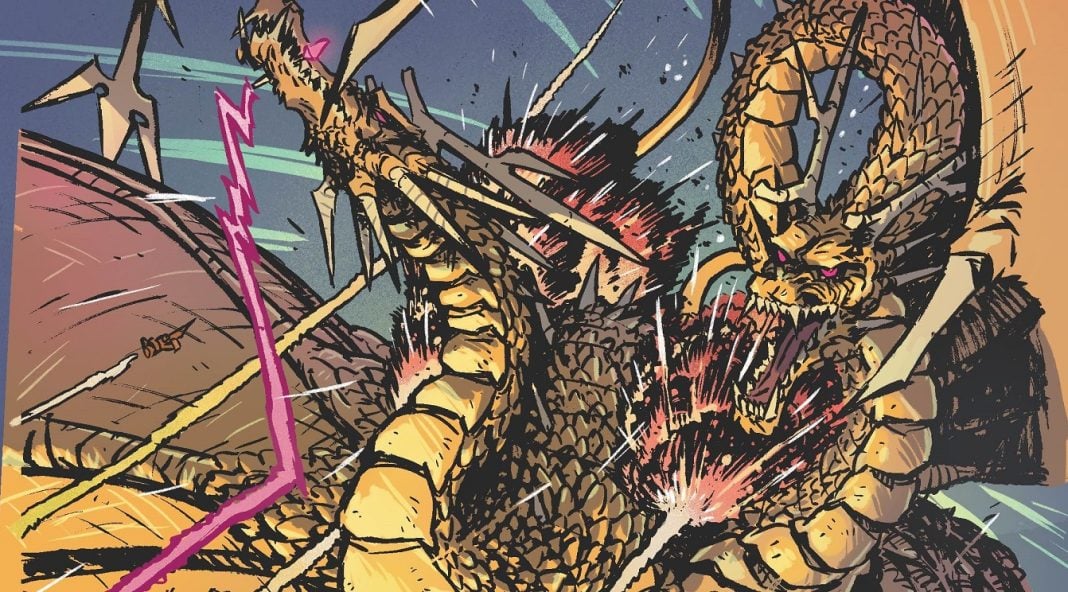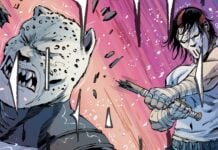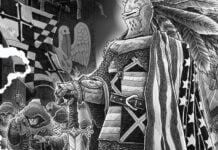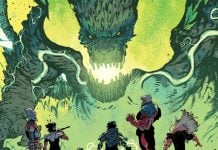It’s no exaggeration to say that everyone’s favorite King of the Monsters, better known as Godzilla, as been experiencing a renaissance in recent years not only in cinema but also in comics through IDW. After renewing the license with Toho a few years ago, there’s been renewed creative with the publisher’s various innovative Godzilla books. This year, IDW has embarked upon perhaps its most ambitious venture with Godzilla by launching a new shared universe line of comic book titles known as the “Kai-Sei Era.” IDW recently debuted a new ongoing Godzilla title, the flagship book of the line, as well as the post-apocalpytic Godzilla: Escape the Deadzone series. Before the end of the year, fans can look forward to Starship Godzilla, a sci-fi book set in space available this October.
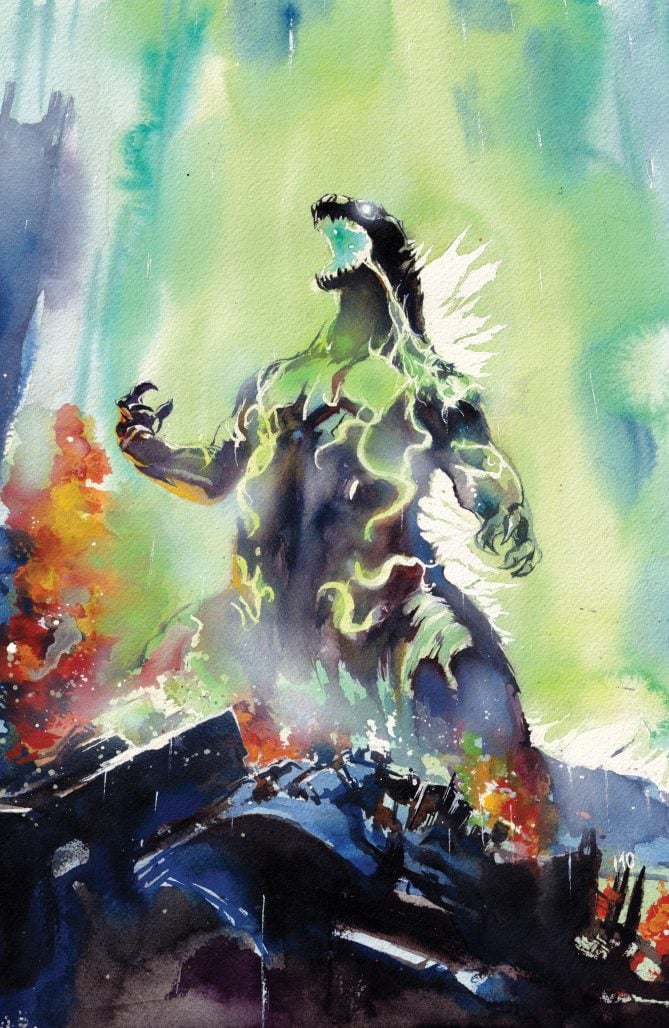
The Beat had the pleasure of conducting a virtual interview with the various creators involved in the Godzilla Kai-Sei Era line including editor Jake Williams, flgaship Godzilla book writer Tim Seeley, Godzilla: Escape the Deadzone co-writer Ethan S. Parker, as well as Chris Gooch and Oliver Ono the respective writer and artist of Starship Godzilla.
The interview has been edited for length and clarity.
Taimur Dar: Some people have compared IDW’s Godzilla Kai-Sei Era shared universe to the Ultimate Universe from Marvel or the Absolute Universe from DC Comics. Though there is some validity, in previous interviews Jake has been somewhat hesitant to call it a completely accurate description. I actually think your approach is not too dissimilar to what James Gunn is doing with the new DC Universe in film and TV with each project being self-contained and having its own tone.
Jake Williams: It’s funny doing interviews and finding out that I’m arguing with myself. Did I say it wasn’t like those things? We can compare it to those. I think the way it’s dissimilar to those projects, be it Ultimate or Absolute, are distillation of years and years of storytelling. What’s funny about the Godzilla canon is that the Godzilla canon has basically never existed. It’s not that we’re doing our own version of the canon. We’re just doing our own version of Godzilla which almost happens every time a Godzilla story is made or told. What’s different with how we’re doing it is we’re setting these multiple stories on the same timeline and trying to tell them in a way that adds to each other without necessarily needing to have each part. They can stand alone, which I think is the James Gunn thing you’re talking about. Peacemaker feels and looks so different in the same way that Superman feels like its own thing. Speaking of Peacemaker, Tim Seeley wrote a tie-in comic! Peacemaker feels like its own thing just like Superman feels like its own thing. It’s almost funny they exist in the same universe.
If you look at the original Marvel comics that’s what made crossovers cool. The Hulk and Doctor Strange and Fantastic Four had nothing to do with each other. They had different tones and styles. Having an Asgardian god crossover with a high school kid is cool. Godzilla, Deadzone, and Starship are all these different flavors. Interviewers early on [said], “Starship must be in the far future and Deadzone is a dystopia so it must be later.” No, it’s all at the same time. The universe is big. There’s room for different types of stories and tones.

Taimur Dar: With any type of licensed property, there are obviously guardrails and parameters but at the same time you want to take some big swings. For instance, there was a Transformers: EarthSpark animated series a few years ago that made some big deviations from established lore such as having Megatron a good guy. The first issue of the main Godzilla series introduced Lament, a kaiju with human-level intelligence. Were there any ideas for the Godzilla Kai-Sei Era books that received any kind of pushback?
Tim Seeley: Not really. I think the flexibility of Godzilla is so built into Godzilla. Part of the appeal is the different tones. There are children’s movies and serious movies. That flexibility means when you come up with crazy stuff like a talking kaiju as the bad guy. It works as long as its rooted in the mythology.
Jake Williams: I wonder what you guys think the rules and boundaries are?
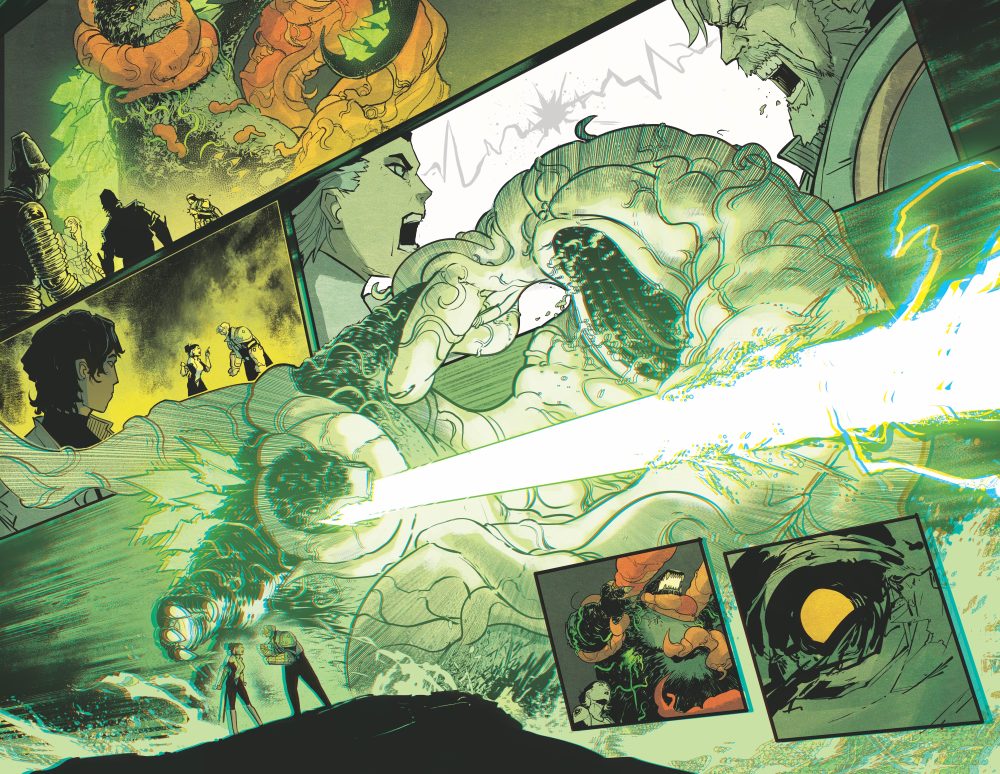
Tim Seeley: You can’t change what Godzilla is about. Godzilla is an entity who is a form of revenge against humanity for something. Whatever it is, Godzilla is some kind of punishment for man being arrogant and cruel. That’s the only thing you have to keep. And then other things happen.
Ethan S. Parker: I know [co-writer] Griffin [Sheridan] and I tried to get you to let us have Godzilla be an alter ego, like a man could turn into Godzilla. That was over the line. We got our Godzilla man in one way or another eventually in a different roundabout way.
Jake Williams: That was a funny thing because it’s a different kind of story. We were talking about making sure it includes Godzilla in some way but we also told them that it can’t be a Godzilla man. It’s not Godzilla but he has green spikes on his back.
Ethan S. Parker: We found a loophole.

Jake Williams: Chris, I feel like we hit more boundaries as you were pitching.
Chris Gooch: The core concept didn’t change. It was a crew piloting a starship based on a kaiju in space. There was definitely tweaking to make it fit with the tonal rules. Originally, I had no idea there was a shared universe so I just pitched it as Godzilla in space. Then it was Mechagodzilla. It was really just tweaking a few things. I would say 99% creative freedom.
Jake Williams: Chris’ original pitch was [set] in the far future and it was actual Godzilla had been turned into an actual starship.
Chris Gooch: The original idea was the ship is the constraints on the kaiju and the crew were more evil because they were manipulating him into doing stuff. We probably couldn’t have done that in the same universe.
Ethan S. Parker: We just gotta wait for the Kai-Sei Universe to be doing Elseworlds!
Jake Williams: It’s like when you see the Bob’s Burgers original 5-minute pilot. It’s still the same heart and vision but it’s Mechagodzilla which was a pitch from Aaron, our Toho guy.
Oliver Ono: I don’t know if you remember, but my initial drawings from the brief were just going to be the head and neck. The thrusters were on the back of the neck and in space it would connect with the body. Perhaps that was too far. I wished we had gotten to do that.
Jake Williams: It’s a fun visual, the head detaching as a tiny spaceship.
Taimur Dar: I think it’s fair to say that Godzilla: Escape the Deadzone has the darkest tone in the Kai-Sei Era line. It seems very reflective of the world right now. I’m curious Ethan, do you find your yourself channeling current world anxieties and fears as you write the book?
Ethan S. Parker: That’s a good question. The big appeal of the book is our characters can run across anyone in the Deadzone. Any kind of weird freak and situation. We have a Church of Godzilla that is absolutely bananas. They have the weirdest rules and rituals. I don’t know if we ever sit down and say, “This is going to be a parallel to this.” Certainly, I think our worldview leaks in no matter what. This is a time when it feels like anyone you meet could be the craziest person you ever met, and it feels like everyone is fending for themselves at a time when things are happening that we never thought could happen. The attitude of the Deadzone is something we found very relatable where all of the characters are, “I guess this is how we’re living now. We’ll just keep rolling with it.” Everyone has to accept these absurd situations. That’s something we not only relate to but also we love in characters.

Jake Williams: Godzilla is explicitly not a sanitized IP. Every time a movie comes out and does really well it’s like Shin Godzilla which is directly reflecting on that person’s issue with their culture. What’s so interesting about these IPs, which is such a gross word, the initial story is so full of anger and angst about a situation. Whether it’s Superman getting involved in the war or Captain America fighting Nazis or Godzilla being explicitly this character born out of a nation’s anguish. You see it with Ethan’s story and you see it with Chris’ story which is a bunch of people trying to get by in the middle of a galactic war. With Tim’s story, it’s a bunch of people who feel like their country didn’t turn out the way they were promised it would because of this thing. That thing you just give face to as Godzilla.
Ethan S. Parker: Godzilla is just a walking disaster and these are disastrous times. So it’s not hard to write about people that are living in the aftermath of a disaster or the middle of one or actively trying to fight one.
Oliver Ono: Usually they’re retrospectives on a specific thing. What we have is a chance to do with the Kei-Sei Era as a whole is as our real life disasters unfold, so too does our story.
Taimur Dar: Shifting gears to Starship Godzilla, I think the easy comparison is Star Trek. I also get a Guardians of the Galaxy vibe with the colors as well as the joyful brightness of Superman. Can you discuss the influences?
Chris Gooch: In terms of references, I can tell from Oliver’s work we were on the same page with ‘80s and ‘90s anime high energy stuff mixed in with high concept experiment things like Cowboy Bebop. That was probably our basis. I’m not a huge Star Trek guy. I’ve seen Next Gen. I definitely want a monthly comic book to be as interesting and creative and new and exciting as it can be. Especially with a universe that’s pre-existing. As a reader you know so much of what you’re expecting going in. So it’s important to be as weird and fun as you possibly can with the different world and characters and setup. Sometimes I’ll open a comic and wonder why am I watching two guys in government suits talking to each other about Superman instead of Superman punching somebody?
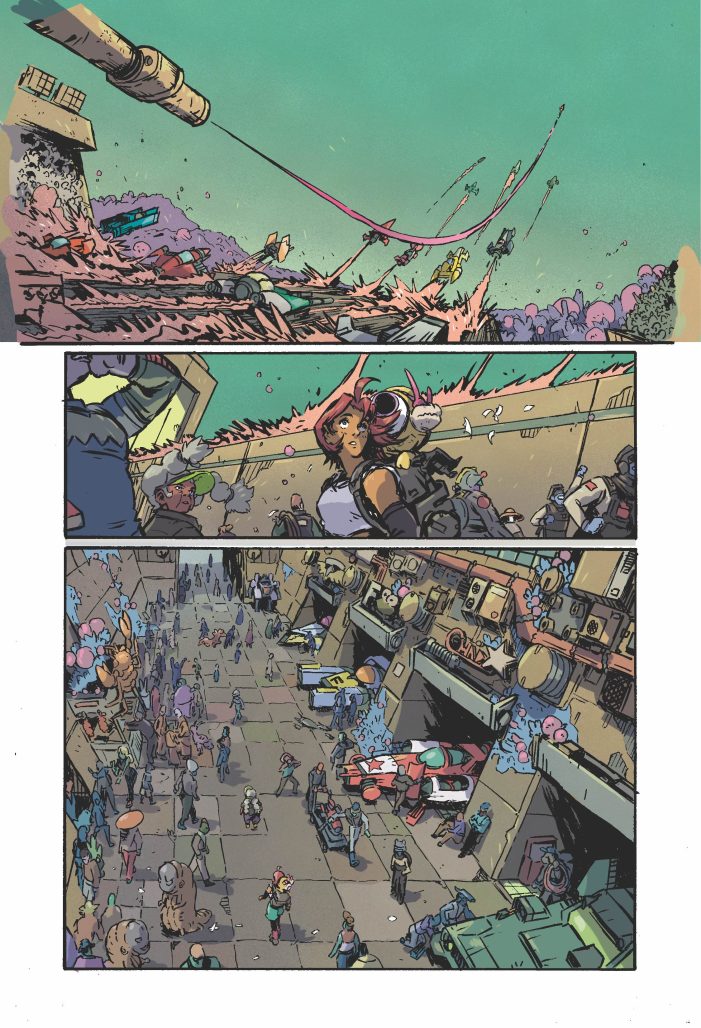
Oliver Ono: I love sci-fi. [Regarding] Star Trek, I’m a big Voyager fan. With each one of the worlds, any alien you’ve ever seen in sci-fi is based on something on Earth. We just pull from the weirdest stuff we can find here. The human imagination is really limited to things we can touch and feel and Google. The colors and the punchiness comes from striving to find something that is further from what we actually have here. Connecting it back to the question of colors having a hopeful nature, it’s an ensemble comic. We have multiple protagonists. Ayan is probably our main protagonist. There are different philosophies on how to get by in the world. That comes to a head in the first issue. My favorite character is Ayan and she fights for what is going to have the least negative result. But other members of the crew are more practical. We definitely come at it from multiple takes but I’m very hopeful when drawing it.
Chris Gooch: It’s meant to be a page turner for sure. It’s so hard to describe something when you know what’s going to happen but talk in vague terms that doesn’t spoil and is still interesting.
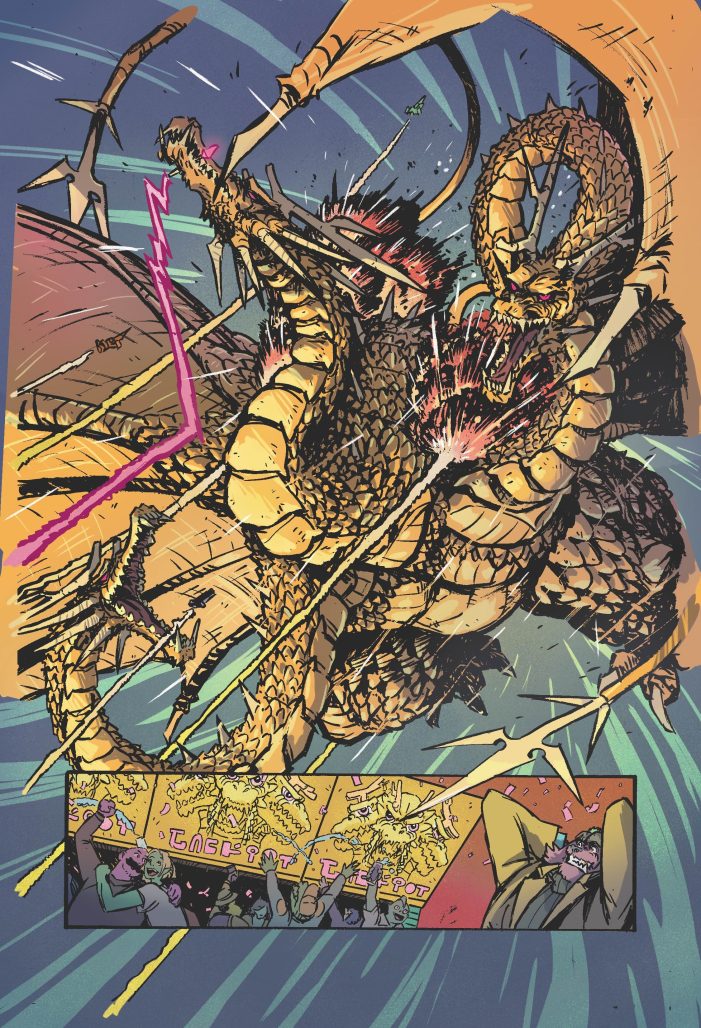
Taimur Dar: I’m not an expert on Godzilla lore, but I have a base knowledge. Thus, I wasn’t aware how the various kaiju such as King Ghidorah, who appears in the second issue of Starship Godzilla, have been reinterpreted for each era. How are you reimagining the different kaiju for the Godzilla Kai-Sei Era?
Jake Williams: In general with the kaiju, even Ghidorah, we’re showcasing an encounter with a god. We’re being pretty soft on when we give a full origin. Starship Godzilla shows an encounter with Ghidorah but it’s not setting a flag on where Ghidorah has been for the last thousand years. Overall, we’re doing that with Godzilla and the other kaiju. It’s tough because you only have so many of them and you want to make their interactions feel important. Part of the job is obfuscating stuff like that until you’re ready to stake your claim.
Tim Seeley: A lot of those cinema versions of those kaiju are canon and important [like] King Ghidorah, Mothra, and Rodan. Then there’s a lot of them that are crazy one-off monster movie stuff. The way we try to approach it is establish the ones that have to be there. Others like Anguirus or Gigan, there are new ways to do them. I don’t think we feel as constrained that they have to follow every previously established continuity. But we have to make sure when they appear they are impactful. They have to serve a function to our story. Our job is to make you feel something that doesn’t need to make you feel that you need to check Wikipedia. We have to make you feel awe and fear.
Jake Williams: Chris, you have a big kaiju you’re going to use soon. Did you look into how it’s been used in the past?
Chris Gooch: I Googled and watched a bunch of old movies. I pretty much had an idea how I wanted the kaiju to come across which is huge roaming extraterrestrial planet-sized monsters. Part of making the world feel organic is having people stumble upon these creatures and have them embedded in the everyday workings of the spaceside of the universe. I remember [you said] the key thing for an artist with Godzilla is being able to do the scale otherwise the threat and scenario is never properly communicated. The kaiju you’re alluding to I want to be old and ancient. This is like being in the depths of the ocean and you cross paths with something and move on.
Jake Williams: One thing that was on the cutting room floor with your book was how the characters originally saw Ghidorah. I think they were having an argument and they realized Ghidorah was passing by the spaceship. It was a moment of quiet when they took in this god going by.
Chris Gooch: I think it was blackout in space and they were dead in the water. The other thing is you can’t just have the creature be the backdrop. It’s a balance between making sure you get what you paid for and doing something new and creative.
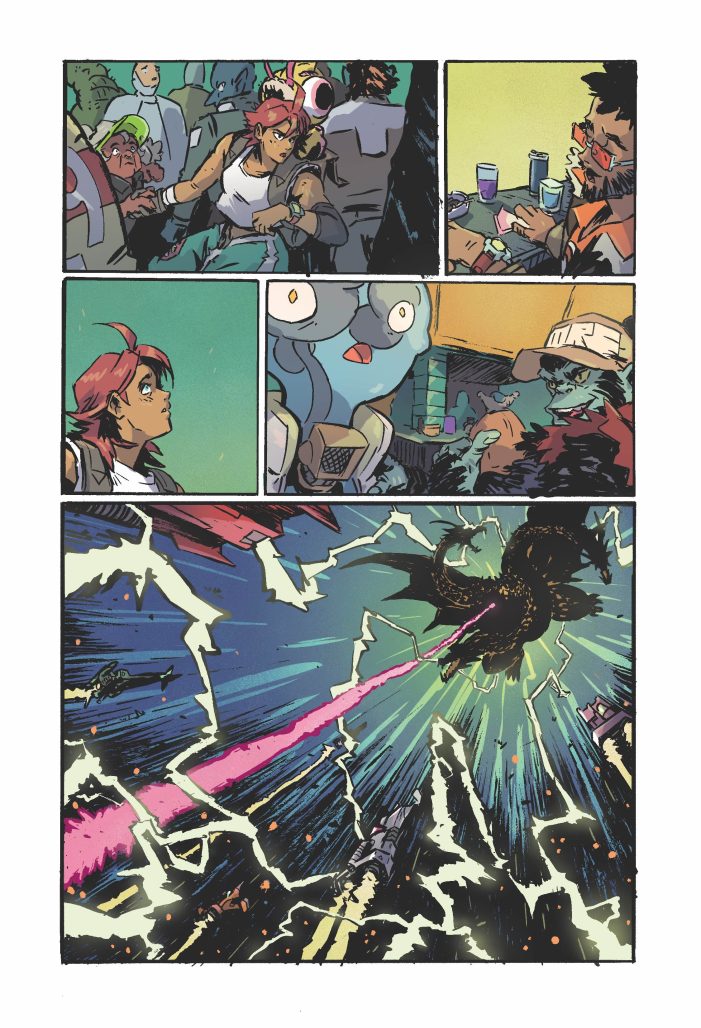
Taimur Dar: With the Marvel Cinematic Universe, we knew at a certain point that there was an “endgame” (pun intended) that was leading up to a big confrontation with Thanos and the Infinity Stones. Can we assume the Godzilla Kai-Sei Era line is heading towards some big grand crossover event down the line?
Jake Williams: I’d say that we are leading to a big crossover eventually. When you’re writing anything, there’s still always this moment when you get to the finale and [say], “How do I want to end this?” The Kai-Sei Era is kind of a storytelling experiment in the sense that we have not gotten together and decided what we are building towards. I keep referring to it as jazz. They’re all telling their stories. If you’re paying attention, you can see the ways it will naturally flow into each other. The MacGuffin or “Thanos” is right there in the name on every book. It’s Godzilla! Godzilla is going to bring them all together at some point. That’s what it’s all leading to. Them all having to fight Godzilla. Tim’s role is keeping an eye on all the other books and figuring out how to thread it into his book.
Tim Seeley: [My book] is the one that most closely parallels a Godzilla film. We’ve got Godzilla and G-Force. Obviously, we’re taking a different lean to it. Because this is the base book, the job is to slowly show why these things occur and why there are different genres. We know very early in my series what happened to this world which will tell you what happened in Deadzone and eventually in Starship Godzilla but without constraint. We want to make sure if you’re investing in these books that you’re going to get that cool payoff. That’s the reason to get comics. You mentioned the Marvel Universe. They just stole that from comics. That’s comics, not cinema. That’s the reason to do a Godzilla comic.
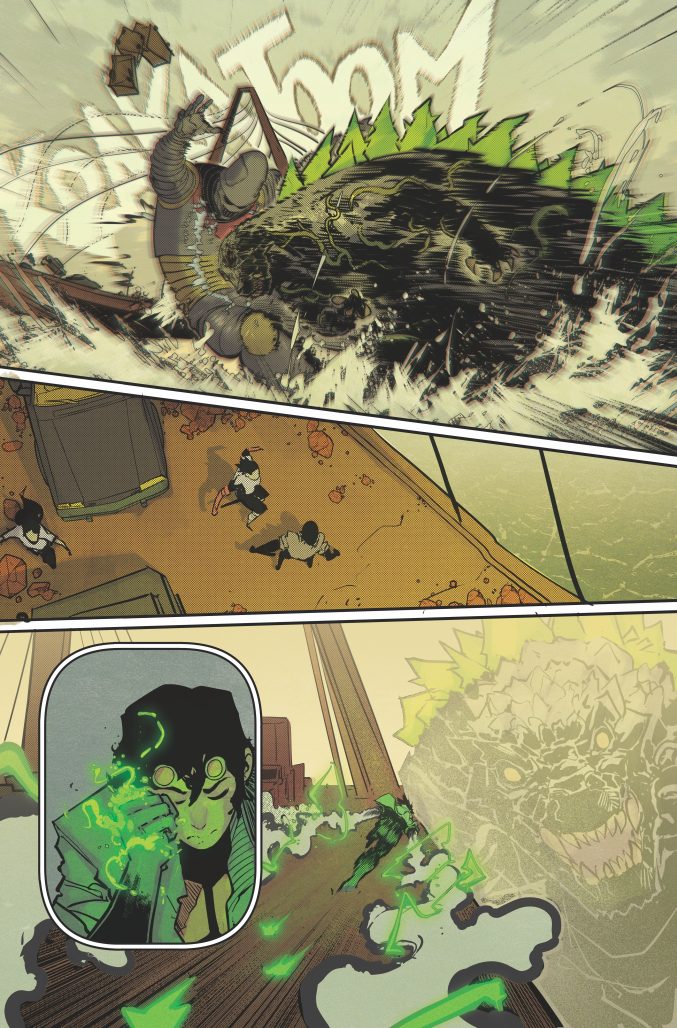
Ethan S. Parker: I think about that a lot with Deadzone. We get into it later in the series, so much of our world doesn’t know that our characters in the Deadzone exist. The government has locked it away from the rest of the world. So much of it is a mystery to the world at large. Maybe there are characters powerful enough to destroy or save the world. There’s a lot of thought whether or not these characters are going to take the world stage. It’s exciting that they’re under this rock and having the potential to turn it over and spilling it out.
Jake Williams: Watching Tim write his stuff as he learns more about other things, you can see him squirreling nuts away. Whether or not this chest will open later and reveal exactly what it thought it would when he first stuffed the chest closed, he knows where to start seeding things that will bring the most joy in the moment. That’s what’s happening here. And honestly, it’s what’s happening in the Marvel Universe as well. They don’t know exactly how it’s going to play out the whole time. That’s the joy of it. They then figure out a way to make it feel like they did the whole time. [Laughs]. We have plans and where it’s going. Like any other comic book, if it had to end in a year we could figure that out. If it had to end in five years, we could figure that out. It’s just building things and putting them in the proper places.


